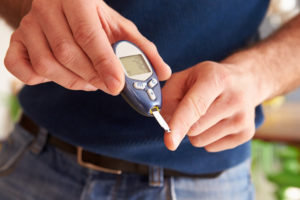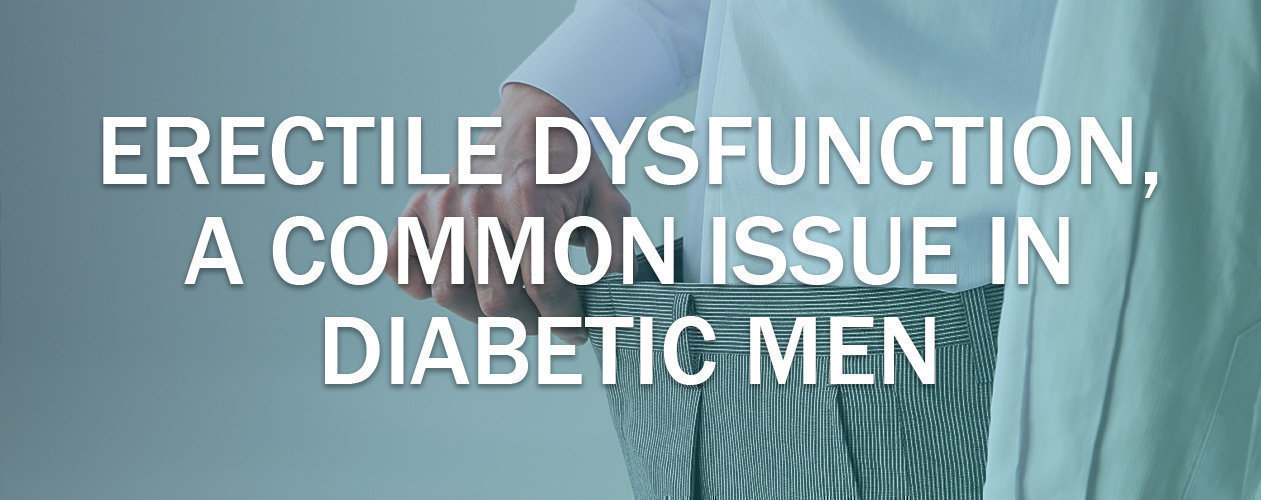Erectile Dysfunction, A Common Issue In Diabetic Men
Background
Diabetes mellitus is one of the most common chronic diseases in nearly all countries. It is increasing rapidly in every part of the world, to the extent that it has now assumed epidemic proportions. In 2012, more than 371 million people had diabetes, and this is expected to rise to 552 million by 2030, rendering previous estimates very conservative.
Diabetes is an established risk factor for sexual dysfunction in men, as a threefold increased risk of erectile dysfunction was documented in diabetic men, as compared to non-diabetic men. Diabetic people may present several clinical conditions, including hypertension, overweight and obesity, metabolic syndrome, cigarette smoking, and atherogenic dyslipidaemia, which are themselves risk factors for sexual dysfunction. The adoption of healthy lifestyles may reduce insulin-resistance, endothelial dysfunction, and oxidative stress, all of which are desirable achievements in diabetic patients. Improved well-being may further contribute to reduce and prevent erectile dysfunction.

How important is your sex life?
Sex is an important part of a relationship for adults of all ages. An unsatisfying sexual life can lead to feelings of guilt and rejection, causing problems in a relationship. Levels of sexual desire vary between different people and can change over time.
Sexual problems can be very difficult to talk about, especially if the cause has not been identified. Therefore, it’s important to know how to recognize the causes and symptoms of sexual dysfunction, so that it can be identified, discussed and treated or managed.
How diabetes affects your sex life?
Erectile dysfunction is a common issue in diabetic men. Not being able to get or keep an erection, is the main sexual complaint men with diabetes. Of course, all men have trouble with erections sometimes, especially as they age. But if you have diabetes, you’re twice as likely to have ED at a younger age.
You have ED if you have trouble with erections one out of every four times. Nerve and artery damage from poor diabetes control is a likely cause because it disrupts blood flow to your penis. You’re also more likely to have heart disease because of this damage, which slows blood flow to your heart.
ED can bring your mood down. It can lower your self-esteem, make you depressed and anxious in bed, and cause stress between you and your partner.
Sexual dysfunction is more common in people with diabetes because poorly controlled diabetes can damage the blood vessels and nervous system causing reduced blood flow and loss of sensation in sexual organs.
Sex involves more than just genitals. Pain in any part of the body can make it hard to relax and enjoy sexual activity, and some diabetes complications can cause pain. Fatigue can make sex seem like more trouble than it’s worth, and diabetes can be related to fatigue in numerous ways, from interfering with a person’s sleep to causing a person to feel constantly drained from the effort of coping. Both high and low blood glucose can affect a person’s mood, energy level, and interest in sex.
Then there are the psychological effects of having diabetes. While many people with diabetes have a strong sense of self-worth, some feel that having diabetes or its complications makes them unattractive to others. These people fear that no one will want them as a partner. If people feel bad about themselves, they may lose their sexual desire or withdraw socially.
What is ED?
The International Society for Sexual Medicine defines ED as a man inability to achieve or maintain an erection suitable for satisfactory sex. When a man is sexually aroused, nerves and chemicals work together to relax smooth muscle tissue and widen arteries so that the penis can fill with blood. Veins constrict to keep the blood inside the penis, forming the erection. Once the man ejaculates, the blood is released back into the body.
ED can happen for many reasons, both physical and psychological. The most common causes of ED are poor blood flow to the penis, nerve damage, hormonal issues, medication side effects, Peyronie’s disease and psychological and emotional issues.
Also, adopting a healthy lifestyle can preserve your erectile function. Smoking, obesity, drug and alcohol abuse, an unhealthy diet and poor exercise habits can contribute to other health conditions associated with ED.
Prevalence of ED in diabetic men
A high percentage of men with diabetes will experience at least some degree of erectile dysfunction, also called ED or impotence, during their lifetime.
Men with diabetes tend to develop ED 10 to 15 years earlier than men without diabetes.
As men with diabetes age, ED becomes even more common. Above the age of 50, the likelihood of having difficulty with an erection occurs in approximately 50% to 60% of men with diabetes. Above age 70, there is about a 95% likelihood of having some difficulty with ED.
Causes of ED in diabetic men
The causes of ED in men with diabetes are complex and involve impairments in nerve, blood vessel and muscle function.
Diabetes damages the blood vessels and nerves that control erection. Even if you have normal amounts of male hormones and you have the desire to have sex, you still may not be able to achieve a firm erection.
Many diabetics develop neuropathy, atherosclerosis, venous leak, and low testosterone. These conditions can cause erectile difficulties for men.
- Neuropathy is a nerve disorder. In normal circumstances, when a man is sexually aroused, a message travels through his nervous system to signal the start of an erection. For a man with neuropathy in his penis, this transmission gets disrupted and the penis does not respond in a typical way. Experts don’t know why neuropathy occurs in diabetics, but it is a major contributor to the high incidence of ED in people with diabetes. Some experts believe that abnormal proteins formed by high blood sugar cause the nerve damage. Blood sugar could also interfere with message transmission.
- Atherosclerosis is a hardening or thickening of the arteries. When a man has an erection, his penis fills with blood. Arteries are a critical part of this process, as they expand in response to sexual stimulation and allow blood in. Veins constrict to keep the blood in the penis until the man ejaculates. Then, the blood flows back into the body. Atherosclerosis makes it difficult for blood to enter the penis. Depending on how severe the condition is, the blood flow may be insufficient for an erection firm enough for sex.
- A venous leak occurs when veins are unable to keep enough blood in the penis for a suitable erection. As noted above, a firm erection results when blood flows into the penis. Veins normally constrict to keep the blood inside until the man ejaculates. A venous leak prevents blood from staying in the penis. Instead, blood leaks back into the body and the erection fail to stay rigid. A venous leak is often caused by problems with smooth muscle tissue, which needs to relax for a good erection to occur. Studies have shown that many diabetic men have less smooth muscle content and that this tissue does not always relax properly.
- Low testosterone is another common problem for diabetic men. Testosterone is a sex hormone that affects a man’s sex drive. Testosterone deficiency can lead to ED.
- Norepinephrine and acetylcholine-positive fibres in the corpus cavernosum have also been shown to be reduced in people with diabetes. This results in loss of the autonomic nerve-mediated muscle relaxation that is essential for erections.
The natural history of ED in people with diabetes is normally gradual and does not occur overnight. Both vascular and neurological mechanisms are most commonly involved in people with diabetes.

How can I prevent or control ED?
One of the most important things you can do is to control your diabetes. You should take medications as prescribed and pay close attention to diet and blood sugar readings. Exercise is also important, as it keeps blood moving around the body helping blood vessels stay open, lessening the chances of atherosclerosis.
To reduce your risk of ED, consider:
- Losing weight;
- Exercising regularly;
- Eating well;
- Quitting smoking;
- Avoiding excessive alcohol use.
Initially, preventive measures will help reduce the risk of developing ED. Improving glycaemic control and hypertension, ceasing cigarette smoking, and reducing excessive alcohol intake have all been shown to benefit patients with ED. Avoiding or substituting medications that may contribute to ED is also helpful.
Once ED has developed, oral agents are considered first-line therapy.
Evaluating ED in diabetic men
The initial step in evaluating ED is a thorough sexual history and physical exam. The history can help in distinguishing between the primary and psychogenic causes. It is important to explore the onset, progression, and duration of the problem. If a man gives a history of “no sexual problems until one night,” the problem is most likely related to performance anxiety, disaffection, or an emotional problem. Aside from these causes, only radical prostatectomy or other genital tract trauma causes a sudden loss of male sexual function. Non-sustained erection with detumescence after penetration is most commonly caused by anxiety or the vascular steal syndrome. In the vascular steal syndrome, blood is diverted from the engorged corpora cavernosae to accommodate the oxygen requirements of the thrusting pelvis.
Questions should be asked regarding the presence or absence of nocturnal or morning erections and the ability to masturbate. Complete loss of nocturnal erections and the ability to masturbate are signs of neurological or vascular disease. It is important to remember that sexual desire is not lost with ED, only the ability to act on those emotions.
A medical history focused on risk factors, such as cigarette smoking, hypertension, alcoholism, drug abuse, trauma, and endocrine problems including hypothyroidism, and low testosterone levels are very important. Commonly used drugs that disrupt male sexual function are spironolactone (Aldactone), sympathetic blockers such as clonidine (Catapres), guanethidine (Islemin), methyldopa (Aldomet), thiazide diuretics, most antidepressants, ketoconazole (Nizoral), cimetidine (Tagamet), alcohol, methadone, heroin, and cocaine.
Finally, an assessment of psychiatric history will help identify emotional issues such as interpersonal conflict, performance anxiety, depression, or anxiety.
The physical exam should focus on femoral and peripheral pulses, femoral bruits (vascular abnormalities), visual field defects (prolactinoma or pituitary mass), breast exam (hyperprolactinemia), penile strictures (Peyronie’s disease), testicle atrophy (testosterone deficiency), and asymmetry or masses (hypogonadism).
Treatment of ED in diabetic men
Because of its multifactorial aetiology, the treatment of ED in diabetic men requires a global approach. The first step is to correct the modifiable risk factors and to promote lifestyle changes, whereas the use of PDE5 inhibitors represents first-line pharmacologic therapy.
Glycaemic control and lifestyle modifications
Although several studies demonstrate an association between poor glycaemic control and the risk of ED, it is still not clear whether intensive glycaemic control may have beneficial effects on erectile function. Many cross-sectional studies have shown that better glycaemic control is associated with improved erectile function. In a study of the Epidemiology of Diabetes Intervention and Complication Study (EDIC), a period of intensive therapy significantly reduced the prevalence of erectile dysfunction among men suffering from diabetes for 10 years or more and microvascular complications, compared with those with a 1 to 5-year history of the disease, but without complications. In type 2 diabetic men, limited data have been reported on risk reduction interventions for ED, and these have had conflicting results.
Lifestyle changes, such as increased physical activity, a Mediterranean diet, and reduced caloric intake, have been associated with the amelioration of erectile function in the general male population.
The suggested mechanisms by which weight loss, healthy diet, and physical exercise can improve erectile function include the amelioration of endothelial dysfunction, insulin resistance, and low-grade inflammatory state associated with diabetes and metabolic diseases, all of which are risk factors for ED.
Pharmacological therapy
- Oral PDE5 inhibitors are considered first-line treatment for ED. These drugs promote erection by inhibiting the PDE5 enzyme, which is responsible for the degradation of cyclic guanosine monophosphate (cGMP) in the cavernous smooth muscle. This inhibition leads to the prolonged activity of cGMP which, in turn, reduces intracellular calcium concentrations, maintains smooth muscle relaxation, and results in rigid penile erections. These drugs differ in their time to onset and in their duration of action, but they show the same efficacy and safety profile. All of them have shown their efficacy in diabetic patients, although it has been reported that diabetic men with ED are less responsive to PDE5 inhibitors when compared with non-diabetic men with ED.
- Intracavernosal injection of papaverine, phentolamine, and prostaglandin E1 (PGE1) (alone or in combination), as well as the intraurethral administration of PGE1, are good alternatives for patients who do not respond to PDE5 inhibitors. Both two treatment modalities have demonstrated efficacy in ameliorating erectile function in diabetic patients.
- Testosterone replacement therapy is recommended in men with ED who show low levels of testosterone. Different formulations are available, such as gels, patches, tablets, implants, and injections. In a prospective, randomized, double-blind, placebo-controlled study, transdermal testosterone replacement therapy was associated with beneficial effects on sexual function in men with type 2 diabetes.
- Mechanical therapy is also effective and is especially well-accepted in men with stable partners. Vacuum-assisted erection devices are effective in creating erections in as much as 67% of cases. Vacuum pressure encourages increased arterial inflow, and occlusive tension rings discourage venous outflow from the penile corpus cavernosae. The penis placed inside the cylinder, a pump is used to produce a vacuum that pulls the blood into the penis. After the tension ring is slipped onto the base of the penis, the cylinder is removed. Erection lasts until the rings are removed.
- Psychotherapy should be offered to the patients and their partners to address any interpersonal conflicts because ED is a problem for couples, not just men.
- A penile prosthesis is a viable option for men who cannot use PDE5 inhibitors and who find the injections or vacuum erection therapy distasteful. A nonadjustable semi-rigid prosthesis is easy to insert and has no postoperative mechanical problems. The inflatable prosthesis has a pump that is put in the testicular sac for on-demand inflation and deflation. Future versions will have a remote-control device like a garage-door opener.

Take home messages:
ED is an under-recognized, under-discussed, and commonly untreated complication of diabetes.
Knowledge of sexual dysfunction in diabetic men is rapidly expanding, and effective oral treatments are now available, as well as injectable drugs, vacuum devices, and inflatable prostheses.
It is therefore important for both physicians and diabetic patients to be educated and aware of the causes and treatments of ED.
References:
- https://www.researchgate.net/publication/260761564_Diabetes_and_sexual_dysfunction_Current_perspectives;
- https://www.medicalnewstoday.com/articles/317194.php;
- https://www.webmd.com/diabetes/head2toe-15/diabetes-erectile-dysfunction;
- https://www.diabetesselfmanagement.com/managing-diabetes/complications-prevention/when-diabetes-affects-your-sex-life/;
- https://www.issm.info/sexual-health-qa/what-is-erectile-dysfunction1/;
- Corona G, Giorda CB, Cucinotta D, Guida P, Nada E, SUBITO-DE study group. Sexual Dysfunction in Type 2 Diabetes at Diagnosis: Progression over Time and Drug and Non-Drug Correlated Factors. PLoS One. 2016; 11(10): e0157915. PMCID: PMC5051725. PubMed PMID: 27706160. DOI: 10.1371/journal.pone.0157915;
- https://www.issm.info/sexual-health-qa/how-does-diabetes-lead-to-erectile-dysfunction/;
- Neelima V. Chu, Steven V. Edelman. Diabetes and Erectile Dysfunction. Clinical Diabetes 2001 Jan; 19(1): 45-47. DOI: 10.2337/diaclin.19.1.45;
- Phé V, Rouprêt M. Erectile dysfunction and diabetes: A review of the current evidence-based medicine and a synthesis of the main available therapies. Diabetes Metab. 2012 Feb;38(1):1-13. PubMed PMID: 22056307. DOI: 10.1016/j.diabet.2011.09.003.

